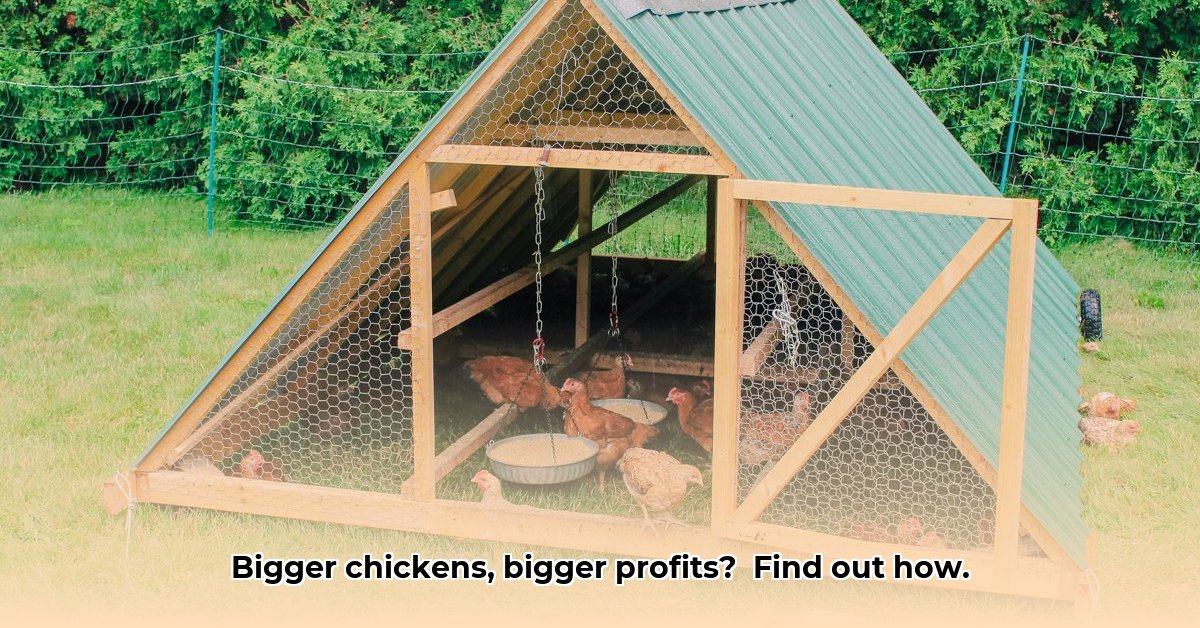
Raising chickens can be both rewarding and challenging. Large chicken tractors offer a sustainable and potentially profitable solution, combining ethical practices with economic viability. This guide will walk you through building or buying, managing your flock, and maximizing your return on investment (ROI). We'll explore the practical and financial aspects, equipping you to make informed decisions and thrive in this unique farming model. For more durable options, check out these PVC chicken tractor plans.
Sizing Up Your Operation: Finding the Right Fit
Choosing the right size chicken tractor is crucial. A larger tractor accommodates more birds, leading to higher egg or meat yields; however, this also increases weight and mobility challenges. Overcrowding leads to stress, disease, and decreased profitability. Consider your land size, the desired flock size, and the ease of moving the tractor when selecting the optimal dimensions. Think of it like choosing a vehicle – a compact car is fine for a small family, but a minivan is needed for a larger one!
Build vs. Buy: A Cost-Benefit Analysis
Building your own large chicken tractor allows customization but demands time, skills, and resources. Purchasing a pre-built option offers speed and convenience, potentially offsetting higher initial costs with reduced labor expenses and faster setup. Weigh the pros and cons: DIY allows for total control, but a pre-built model might prove more economical and time-efficient for those lacking carpentry skills or time constraints.
Pasture Management: The Key to Success
Sustainable pasture management is key to thriving chicken tractor farming. Rotating your flock prevents overgrazing, promoting healthy soil and reducing the need for chemical fertilizers. This holistic approach not only enhances environmental sustainability but also contributes to happier, healthier birds and a higher yield of eggs or meat. A well-planned grazing schedule mirrors natural foraging patterns, leading to healthier chickens and healthier land.
Stakeholder Impacts: A Win-Win Situation
Large chicken tractors benefit more than just the farmer. Improved soil health benefits the environment, while chickens enjoy a more natural, less stressful life. This results in healthier, ethically raised products that appeal to environmentally conscious consumers, creating a wider positive impact on the community.
Financial Considerations: Analyzing ROI
While the initial investment in a large chicken tractor can be substantial, long-term financial gains are considerable. Reduced feed costs due to foraging, higher yields due to healthier birds, and the potential to command premium prices for ethically produced products all contribute to a strong ROI. The reduced effort in cleaning the coop, compared to stationary models, further enhances cost-effectiveness. However, thorough financial planning, including a detailed budget and risk assessment, is essential.
Risk Management: Planning for the Unexpected
Potential risks include disease outbreaks, predator attacks, and soil degradation. Mitigating these risks requires proactive measures: regular health checks for your flock, secure housing designs, and responsible pasture management to prevent overgrazing and soil erosion. Proactive risk management is significantly more cost-effective than reacting to crises.
Regulatory Compliance: Staying on the Right Side of the Law
Before starting, thoroughly research local regulations related to livestock density, animal welfare, and waste management. Failure to comply can lead to significant fines. Navigating legal requirements early ensures smoother operation and avoids potential problems.
Long-Term Sustainability: Growing a Healthy Business
Large chicken tractors promote long-term sustainability. Healthier birds, healthier soil, and a healthier business create a synergistic, environmentally responsible, and profitable farming model. This holistic approach harmonizes environmental stewardship with economic success.
Your Step-by-Step Guide to Success
- Land Assessment: Evaluate land size, soil type, and climate.
- Detailed Planning: Determine flock size and choose a suitable tractor design.
- Build or Buy Decision: Select the most cost-effective and time-efficient approach.
- Infrastructure Setup: Prepare fencing, water access, and other necessities.
- Flock Management: Implement a rotational grazing plan and monitor flock health.
- Sales Strategy: Develop a plan for selling eggs or meat (farmer's markets, online sales, etc.).
Pros and Cons: A Balanced Perspective
| Feature | Pros | Cons |
|---|---|---|
| Mobility | Reduced pasture damage, healthier chickens, easier cleaning | Requires adequate space and might be challenging on uneven terrain |
| Environment | Enhances soil fertility; minimizes reliance on chemical inputs | Higher initial investment compared to stationary coops |
| Economics | Higher egg/meat yields, lower feed costs, potential for premium pricing | Requires meticulous planning and ongoing management |
| Animal Welfare | Improved quality of life for chickens, reduced stress and disease risk | Potential for predation; necessitates vigilant flock monitoring |
This guide provides a framework for successfully utilizing large chicken tractors. Remember that diligent planning, careful management, and a realistic understanding of potential challenges are crucial for success. By combining sustainable practices with sound financial management, you can create a thriving and responsible poultry farming enterprise.